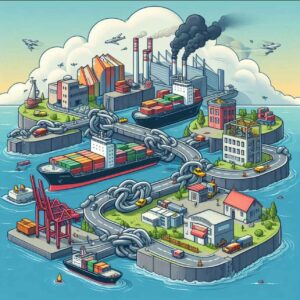Welcome Blessings!
(Tap 🔽 to see more topics!)


When President Donald Trump implemented his controversial tariff policies, they became a topic of discussion not just among economists and politicians but at dinner tables across America. The question on everyone’s mind was: What are tariffs, why are they necessary, and how do they affect the everyday person? Tariffs might sound like something only trade experts need to worry about, but the truth is, they affect all of us… from the price of that new TV you’ve been eyeing to the availability of your favorite snack.
Today’s article will discuss the most frequently asked questions about Trump’s tariffs. You’ll see how they worked, who benefited, who suffered, and what it all means for the future. By the end, you’ll have a clear understanding of how these policies impacted the U.S. economy and the global stage.
Imagine you’re at a farmer’s market. There’s a vendor selling apples, and you think, “Wow, these apples are a bit overpriced.” But there’s another stand across the way selling identical apples for a lower price. The first vendor, frustrated that they’re losing customers, decides to raise the cost of their apples a little more… just enough to make the other stand seem even more expensive.
A tariff is essentially a price hike on imported goods. Countries use tariffs to make foreign products more expensive, encouraging consumers to buy locally produced alternatives instead. The goal is to boost domestic businesses by making their competition less attractive. However, just like that farmer raising the price of his apples, foreign producers don’t always absorb the cost of tariffs. Often, it’s passed down to consumers, raising prices on everyday goods. So, while tariffs might be aimed at protecting local industries, they usually leave shoppers paying higher prices at the checkout.

When Trump took office, his economic mantra was protecting American jobs and industries. A major concern for him was the trade deficit—the gap between what the U.S. buys from other countries and what it sells abroad. According to his administration, this imbalance was a sign that other countries, particularly China, were taking advantage of the U.S. economy. It is like a tug-of-war game. The U.S. was holding the rope, but other countries were pulling harder, gaining an advantage. Trump’s solution? Pull back with tariffs. Trump used tariffs to achieve a few key goals:
Trump’s tariff strategy was like putting up a “no entry” sign for foreign products and hoping that by making it harder to import, American companies would step up and fill the gap.
While Trump may have seen tariffs as a way to protect American jobs, their effects were more complicated than that. Suppose you’re shopping for a new car. If the price of steel goes up because of tariffs on imported steel, the car manufacturers will face higher production costs. They’ll likely pass those costs on to you, the consumer. So, you’ll end up paying more for that car, and other goods like washing machines, televisions, and smartphones could see similar price hikes.
The impact on businesses was equally mixed. On the one hand, domestic steel producers saw a rise in demand as tariffs made their products more competitive. On the other hand, companies that relied on cheaper imported materials faced higher costs, squeezing their profit margins. Farmers were also struck. As China retaliated with tariffs on U.S. agricultural products like soybeans, many farmers found themselves without a reliable crop market. The government intervened with subsidies but didn’t fully compensate for the lost trade opportunities.
Did Trump’s tariffs work the way he intended? The short answer is it’s complicated. In the short term, there were some wins:
But the long-term effects were less clear. Many economists argue that tariffs ultimately slowed the economy. The U.S. didn’t significantly reduce its trade deficit. Higher costs and disrupted supply chains hurt many industries. Consumers paid higher prices for various products, from everyday goods to big-ticket items like electronics and vehicles.

A trade war happens when countries retaliate against each other’s tariffs, creating a vicious cycle of escalating taxes on imports. Under Trump, the U.S. found itself in one of the largest trade wars in modern history, particularly with China.
China imposed retaliatory tariffs on U.S. goods, and the cycle continued. Global trade slowed down, and companies faced uncertainty about the future of their international supply chains. Businesses hate uncertainty, and the trade war didn’t help. Think of it like a tug-of-war as I have mentioned earlier: Both sides keep pulling harder and harder, but no one knows exactly when the rope will snap.
China wouldn’t sit back and let the U.S. have its way. They retaliated with tariffs on U.S. goods… especially agricultural products like soybeans, pork, and cotton. This created a massive headache for American farmers, who suddenly lost a key market for their goods. China also started diversifying its supply chains, moving away from reliance on American-made goods in favor of products from other countries. This pushed U.S. companies to rethink their global supply strategies, leading to shifts in where businesses source their materials and products.
Trump’s administration defended its tariffs using existing laws, such as Section 232 of the Trade Expansion Act, which allows tariffs for national security reasons, and Section 301 of the Trade Act of 1974, which addresses unfair trade practices.
While these laws gave Trump the legal backing to impose tariffs, many of his trade partners argued that his actions violated international trade agreements. The World Trade Organization (WTO) even ruled against some of Trump’s tariffs, but enforcing WTO rulings is another issue.
Before Trump, most U.S. presidents preferred negotiating trade deals and minimizing tariffs. Bill Clinton and Barack Obama focused on free trade agreements and international partnerships. On the other hand, Trump took a more combative approach, using tariffs to force countries into renegotiations and pushing for what he viewed as fairer deals for the U.S.
Trump’s strategy starkly contrasted previous administrations that favored cooperation over confrontation. Whether you agree with his methods or not, his approach shifted the global trade paradigm.
The long-term effects of Trump’s tariff policies are still unfolding. In many ways, the U.S. is still adjusting to the changes from a more protectionist approach to trade. While some industries saw short-term gains, others still grapple with higher costs and disruptions in global supply chains. One thing is clear, though… Trump’s tariffs made trade wars a regular topic of conversation. They set a precedent for future leaders who may use similar tactics to advance their agendas.
Ultimately, the ones who bore the brunt of these tariffs weren’t just foreign companies but American consumers and businesses. While some domestic manufacturers saw short-term gains, many Americans paid more for everyday goods. For example, American farmers were hit hardest by retaliatory tariffs imposed by China. Products like soybeans and pork were taxed, leaving U.S. farmers with a shrinking market for their goods.
What you can do about it? Consumers should know that tariff-induced price hikes may affect various goods, from electronics to food. Being conscious of the impact tariffs have on your spending is crucial. In some cases, it might make sense to adjust your shopping habits or consider local alternatives.
As the U.S. emerges from Trump’s presidency, questions remain about the future of trade policy. Will tariffs continue to play a central role in U.S. economic strategy? Or will future leaders focus more on trade agreements and cooperation? The global trade environment is in flux, and Trump’s tariffs’ impacts will likely shape trade discussions for years.
What you can do about it? Stay agile! Whether you’re a business owner or a consumer, the best way to prepare for the future is to embrace adaptability. Understand that tariffs may still influence the market, and be prepared for shifts in pricing and availability.

Looking back, those tariffs? They shook things up, didn’t they? Like dropping a pebble in a still pond, the ripples spread and touched everything from big international deals to the daily price tags. Regardless of where you stand on the ‘Did they work?’ debate, one thing’s sure… the world’s economic dance floor got a new set of steps.
So, where do we go from here? It’s less about dwelling on the past and more about being smart about the future. It is just like learning to read the weather. You don’t need to control the clouds to know when to grab an umbrella. For us, that means keeping an eye on those price changes and maybe tweaking our shopping habits. If you’re running a business? Flexibility is your superpower!
Those tariffs reminded us that we are all connected in this big, global economy. We are all in the same boat, and knowing how to face these changes is key to keeping it afloat. If you’re curious to learn more about how to adapt to these shifts, consider exploring resources on economic forecasting and personal finance strategies. It’s about empowering yourself with the knowledge to prepare you for whatever comes next. Voila! Until next time!